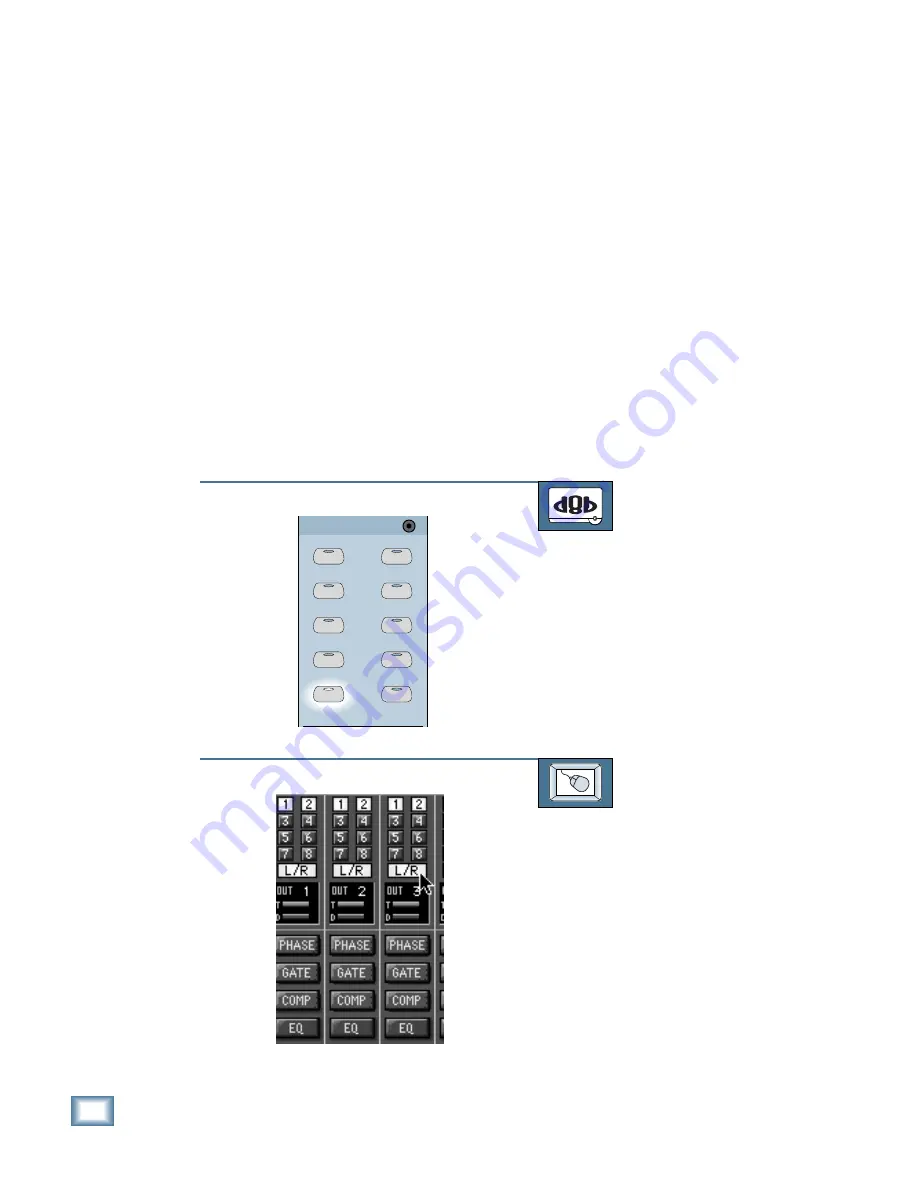
6-66
D i g i t a l 8 • B u s
Starting a New Session
Routing Channels to Mains and Subs
You should normally use the L-R Mix buses as
your main or house feed. Patch out from the L-R
outputs (preferably the balanced XLR outputs)
into the input to your amp stack (usually your
house graphic equalizer).
If you’re used to assigning groups of instruments
or voices to a submaster so you can control the
level of an entire group with a single fader, you’ve
probably realized by now that the submasters on
the Digital 8•Bus don’t patch directly to the L-R
outputs. We did anticipate your need for this,
however. That’s why there are eight Virtual Group
Faders in Fader Bank 4. See “Virtual Grouping/
Ungrouping” in Chapter 8 to see how they work.
You can use the submaster outputs as indepen-
dent outputs for a variety of purposes. In our Live
Mixing hookup example on page 6-79, we are us-
Assigning Channels to the L-R Bus
TO ASSIGN CHANNELS TO THE L-R BUS
From the console:
1. Select the Fader Bank containing the
channels you want to assign to the
L-R bus.
2. Press the L-R button in the Bus
Assignment Section.
3. Press the ASSIGN button on all the
channels that you want to assign to
the L-R bus.
TO ASSIGN CHANNELS TO THE L-R BUS
From the screen:
1. Click on the Fader Bank button con-
taining the channels you want to
assign to the L-R bus.
2. Click on the channel L-R assign but-
tons on the channels that you want to
assign to the L-R bus.
3. If you want to assign multiple con-
secutive channels, click and hold the
mouse button on the first channel’s
L-R assign button, and swipe the cur-
sor across the row of L-R buttons.
ing all eight submaster outputs to connect to an
8-track recorder. But you can use them to create
a separate submix for special monitoring pur-
poses, or even as additional aux sends.
If you assign a channel to an odd/even pair of
buses (i.e., Buses 1 and 2, Buses 3 and 4, etc.),
the channel pan control pans the signal between
the two buses.
If you really need to assign audio buses 1-8 to
the L-R mix, you can route the bus outs to the
ALT I/O returns 1-8 and then assign the returns
(Fader bank 3) to the L-R mix. This will also al-
low you to add effects to the buses, by sending
auxes from the returns to the effects, and return-
ing the effects to the mains.
You can also bring the buses into the channels in
the same manner, for even more DSP processing.
BUS 1
BUS 2
BUS 3
BUS 4
BUS 5
BUS 7
BUS 6
BUS 8
L-R
ROUTE TO
TAPE
ASSIGNMENT
ASSIGN
ASSIGN
ASSIGN
ASSIGN
ASSIGN
ASSIGN
ASSIGN
ASSIGN
ASSIGN
ASSIGN
Summary of Contents for 8-BUS Series
Page 49: ...3 16 D i g i t a l 8 B u s Start Up ...
Page 57: ...4 8 D i g i t a l 8 B u s Connections ...
Page 77: ...5 20 D i g i t a l 8 B u s Preparing for a Session ...
Page 177: ...7 20 D i g i t a l 8 B u s Automation ...
Page 207: ...D 2 D i g i t a l 8 B u s Apogee UV22 ...
Page 219: ...F 4 D i g i t a l 8 B u s Optional I O Cards ...
Page 227: ...H 2 D i g i t a l 8 B u s Upgrading ...
Page 235: ...K 2 D i g i t a l 8 B u s ...
Page 237: ...D i g i t a l 8 B u s ...
Page 239: ...D i g i t a l 8 B u s ...
















































